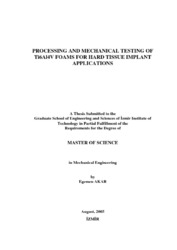Please use this identifier to cite or link to this item:
https://hdl.handle.net/11147/3187Full metadata record
| DC Field | Value | Language |
|---|---|---|
| dc.contributor.advisor | Güden, Mustafa | - |
| dc.contributor.author | Akar, Egemen | - |
| dc.date.accessioned | 2014-07-22T13:51:02Z | - |
| dc.date.available | 2014-07-22T13:51:02Z | - |
| dc.date.issued | 2005 | - |
| dc.identifier.uri | http://hdl.handle.net/11147/3187 | - |
| dc.description | Thesis (Master)--Izmir Institute of Technology, Mechanical Engineering, Izmir, 2005 | en_US |
| dc.description | Includes bibliographical references (leaves: 48) | en_US |
| dc.description | Text in English; Abstract: Turkish and English | en_US |
| dc.description | xi, 48 leaves | en_US |
| dc.description.abstract | Sintered Ti6Al4V alloy powder foams were prepared using atomized spherical powders in the porosity range of 52-72 %. For increasing porosity range, space holder was used. Spherical powder foams were cold compacted at (200, 300, 400, 500 MPa) compaction pressures and then sintered at 1200 °C for 2 h and 1300 °C for 2-4-6 h. The final porosities and average pore sizes were determined as functions of the applied compaction pressure and sintered time.The mean pore size of the foams varied between 94 and 148 mm depending on the particle size range of the powders used and the compaction pressure applied.Microscopic studies of sintered powder foams showed that sintering at high temperature (1200°C and 1300°C) and subsequent relatively slow-rate cooling in the furnace transformed the microstructure of spherical powder from the acicular alpha to the Widmansttten microstructure.In compression testing, at quasi-static, the foams failed primarily by shear band formation along the diagonal axis 45 to the loading direction. Microscopic analyses of deformed but not failed and failed spherical powder foam samples further showed that fracture occurred in a ductile (dimpled) mode consisting of void initiation and growth in alpha phase and/or at the alpha/b interface and macrocraking by void coalescence in the interparticle bond region.The strength of the sintered foams was further shown to satisfy the strength requirements for cancellous bone replacement. The strength of the compacts having porosity level of 40% and/or lower was comparable with that of human cortical bone.Compared to Ti powder compacts of previous studies, Ti6Al4V powder compacts provided higher strength and increased porosity level of the foams suitable for cortical bone replacement. | en_US |
| dc.language.iso | en | en_US |
| dc.publisher | Izmir Institute of Technology | en_US |
| dc.rights | info:eu-repo/semantics/openAccess | en_US |
| dc.subject.lcc | TA418.9.F6 .A31 2005 | en |
| dc.subject.lcsh | Metal foams | en |
| dc.subject.lcsh | Bones--Mechanical properties | en |
| dc.subject.lcsh | Foamed materials | en |
| dc.title | Processing and Mechanical Testing of Ti6a14v Foams for Hard Tissue Implant Applications | en_US |
| dc.type | Master Thesis | en_US |
| dc.institutionauthor | Akar, Egemen | - |
| dc.department | Thesis (Master)--İzmir Institute of Technology, Mechanical Engineering | en_US |
| dc.relation.publicationcategory | Tez | en_US |
| dc.identifier.wosquality | N/A | - |
| dc.identifier.scopusquality | N/A | - |
| item.grantfulltext | open | - |
| item.openairecristype | http://purl.org/coar/resource_type/c_18cf | - |
| item.openairetype | Master Thesis | - |
| item.languageiso639-1 | en | - |
| item.cerifentitytype | Publications | - |
| item.fulltext | With Fulltext | - |
| Appears in Collections: | Master Degree / Yüksek Lisans Tezleri | |
Files in This Item:
| File | Description | Size | Format | |
|---|---|---|---|---|
| T000335.pdf | MasterThesis | 10.34 MB | Adobe PDF |  View/Open |
CORE Recommender
Page view(s)
376
checked on Apr 28, 2025
Download(s)
96
checked on Apr 28, 2025
Google ScholarTM
Check
Items in GCRIS Repository are protected by copyright, with all rights reserved, unless otherwise indicated.